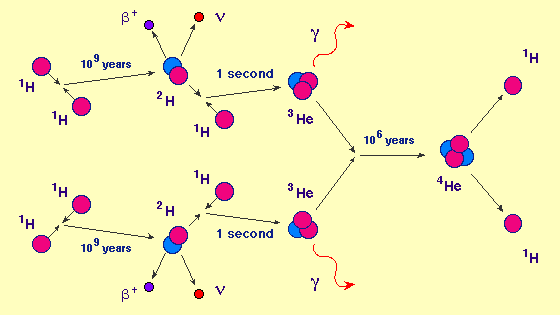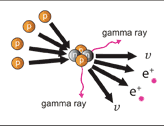proton-proton chain

The proton-proton chain (p-p chain) is the most important energy-producing nuclear process taking place inside relatively low mass stars, such as the Sun. It involves a chain of fusion reactions in which four protons combine to form a nucleus of helium; the process was first described in 1938 by Hans Bethe and the American physicist Charles Critchfield (1910–1994).
The proton-proton chain begins with two protons colliding to form a nucleus of deuterium. Any time such fusion takes place, a tiny amount of mass is turned into a comparatively huge amount of energy. When the two protons fuse to make the deuterium, one of the protons turns into a neutron and releases energy in the form of a positron and a neutrino; the positron annihilates with an electron, creating two gamma rays. The deuterium then combines with another proton, releasing a gamma ray and giving a nucleus of helium-3. Finally, the helium-3 nucleus fuses with another helium-3 to form normal helium. This last step sets free two protons to start the whole process again. The gamma rays produced in the proton-proton reaction take one to 10 million years to work their way out from the star's core, being scattered numerous times and losing energy as they go, until they emerge from the surface as rays of light and heat. Inside the Sun, about 655 million tons of hydrogen are converted into 650 million tons of helium every second.
In stars heavier than about 2 solar masses, in which the core temperature is more than about 18 million K, the dominant process in which energy is produced by the fusion of hydrogen into helium is a different reaction chain known as the carbon-nitrogen cycle.
 |
| Overall reaction
|


